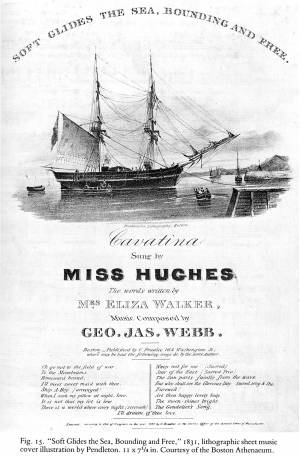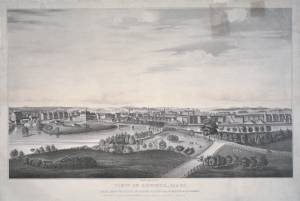An online project under the direction of the CAPE ANN MUSEUM
inv. 445
View of the Old Building at the corner of Ann St., Boston, Mass.
View of the Old Building at the Corner of Ann St, Boston; View of the Old Building at the Corner of Ann Street, Boston, Mass.
1835 Lithograph on paper 6 3/8 x 8 1/16 in. (16.2 x 20.5 cm)
Collections:
|
Explore catalog entries by keywords view all keywords »
Historical Materials
Below is historical information related to the Lane work above. To see complete information on a subject on the Historical Materials page, click on the subject name (in bold and underlined).
Old Feather Store was located at the corner of North (formerly Ann) Street and Dock Square; also see Faneuil Hall and Quincy Market.
Pendleton's was the first lithography shop in Boston and created some of the finest prints from the time period. The firm was founded by brothers, William S. and John Pendleton, in 1826 at Harvard Place. Prior to this firm, William Pendleton had founded the Senefelder Lithographic Company in 1825 with Abel Bowen. (The 1831 Gloucester map was printed by the Senefelder Lithographic Company, and perhaps provided an introduction for Lane to Pendleton.) In 1828, John left Boston to pursue various opportunities in Philadelphia and New York. In the absence of his brother, William built Pendleton's into a well-regarded lithographic shop until 1835 when he sold the shop to his bookkeeper, Thomas Moore. At Pendleton's, many prominent artists were taught, including John H. Bufford, Robert Cooke, Nathaniel Currier, and Lane. The artists at Pendleton's were responsible for producing a variety of materials including maps, plans, portraits, fashion plates, topographical views, music covers, advertisements, and historical prints.
Much of this information has been summarized from Boston Lithography 1825–1880 by Sally Pierce and Catharina Slautterback.
Lithograph
28.5 x 21 in.
Cape Ann Museum Library & Archive
When Massachusetts decreed that each town be mapped, John Mason drew the map of Cape Ann in 1830. This drawing was sent to the Senefelder Lithographic Company of Boston (owned by William Pendleton) to be printed, and then sold in Gloucester by W.E.P. Rogers, whose Gloucester Telegraph of February 12, 1831 announced, "A few specimen copies of the map, uncolored, have reached the town" and that they cost $1.25. Perhaps this business arrangement between Pendleton and Rogers provided Lane with his introduction to Pendleton.
Also filed under: Folly Cove » // Good Harbor Beach / Bass Rocks » // Maps » // Mason, John » // Meetinghouse Green » // Salt Island » // Thacher Island »
Newspaper
"Mr. Lane in his early youth exhibited uncommon proofs of capacity by drawings of wonderful vigor and truthfulness so that they attracted the notice of some of the best judges, among others of Mr. Pendleton, the pioneer of lithography. who took a genuine interest in the young artist and invited him to Boston where greater opportunity could be afforded him for study and improvement. This great promise of early life was fully redeemed in riper years when, self-taught, he mastered the difficulties of the art and took place in front rank of the marine painters of this country. An afflicting malady which crippled him for life prevented him taking extensive journeys for picturesque material but whenever it wass possible for him to reach striking and characteristic views of our coast he visited them and the number of fine works distributed throughout the country show with what judgement he selected his subjects and how happily he rendered them."
Also filed under: Biographical information » // Newspaper / Journal Articles »
Lithograph
7 1/2 x 9 in.
Courtesy American Antiquarian Society, Worcester, Mass.
One of the Pendleton brothers kicking Russell Jarvis out the door of the printing establishment.
Also filed under: Johnston, David Claypoole »
Lithograph
3 7/8 x 2 3/4 in., on sheet 5 1/8 x 3 7/8 in.
Courtesy American Antiquarian Society, Worcester, Mass.
Subject: Advertising card for the Boston lithography firm. A woman sits at a desk, writing on a writing slope. Copied from a vignette signed R. Lane on the title page of C.J. Hullmandel's Art of Drawing on Stone, 1824.
lithograph
1832
"Salmon pinxt" at lower left; "Pendleton, Boston" at lower right
Also filed under: Salmon, Robert » // State House »
Woburn, MA,
"After a time I left the shoe store, and through the influence of my friend Cooke, was admitted as an apprentice to Moore, successor to Pendleton, in the lithographic business. Here I was speedily worked in as a draughtsman for ordinary commercial work, the fine work, such as designs of figures and heads from life being done by Cooke. F.H. Lane, afterwards well-known as a marine painter, did most of the views, hotels, etc. He was very accurate in his drawing, understood perspective and naval architecture perfectly, as well as the handling of vessels, and was a good, all-round draughtsman." (1)
(1) John Wilmerding. Fitz Henry Lane (Gloucester, MA: Cape Ann Historical Association, 2005). Reprint of Fitz Hugh Lane, by John Wilmerding. New York: Praeger, 1971.
Also filed under: Champney, Benjamin » // Cooke, Robert » // Personal Reviews » // Professional » // Publications »
Lithographic sheet music
11 x 7 1/4 in.
Boston Athenaeum
Also filed under: Salmon, Robert » // Sheet Music by other artists »
Lithograph
Printed by Pendleton's
18 3/8 x 15 5/8 in.
Boston Athenaeum
Also filed under: Horticultural Hall »
Lithograph
Printed by Pendleton's
14 1/8 x 23 5/8 in.
Boston Athenaeum
Also filed under: Lowell, Mass. »










Commentary
The building to the left in this 1835 hand-colored lithographic view of Boston was known as The Old Feather Shop, or sometimes The Old Cocked Hat. It was built in 1680, used for a variety of commercial purposes over the years, and razed in 1860. At the time Fitz Henry Lane sketched it, the building was home to John Simpson’s upholstery shop. To the right, across the cobble-stoned intersection is Faneuil Hall.
Although small in size, the complexity of this composition divulges Lane’s mastery of perspective while the subtly shifting tones of the image reveal his skill with the lithographic crayon. Pendleton’s workshop was a training ground for young artists like Lane during the 1830s, a time when few other opportunities for artistic advancement existed in the region.
[+] See More